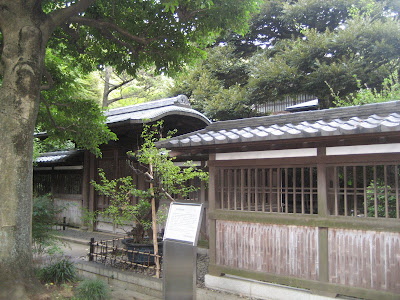Directly across the street from where we are renting a home, there is a perfectly intact Wakan, or traditional Japanese home, that was once the home of one of the wealthiest Tokyo clans, the Maeda clan. This is open to the public, at least the first floor, and you can enter, savor the traditional tatami floor rooms, enjoy the beautiful simplicity of the architecture, then sit by the sliding shoji doors that are opened to reveal what was once this family's private garden. it is so incredibly serene, and it is such a delight that this exists in Tokyo and minutes from a busy street. Here are lots of pictures, minimal commentary, as they speak for themselves.
This is the entrance to the home.
you are looking at the main gate to the home.
this is just a long view of the that gate
this is the formal genkan, where you leave your shoes before stepping up into the home. on the red carpet, slippers are given to you. here, you can see across several rooms and in the far view, a glimpse of garden, but there are lots of sliding doors to hide that view, all are open at the moment.
cabinet, storage space.
more traditional storage space at bottom, and black counter top for pottery, looking through rice paper or shoji toward the back of home with glimpses of garden.
looking down a hallway at a window framed in shoji, and this hallway runs around the home perimeter.
sitting on a cushion, zebuton, overlooking the garden, contemplating life's next move maybe.
Mari enjoying this garden space. It was 10 degrees cooler here so a welcome respite on a hot day.
a view of others enjoying this space. tatami floors, shoji sliding doors, all of a bygone era.
above sliding doors are these elaborate wood carvings, a kind of detail seen in wakan.
a view of other rooms.
another vantage point. sizes of rooms are given in number of tatami mats, not feet or meters.
one last time to the garden for zen meditation for Mari and me, a moment for parents with no Niko.
my favorite view of garden. until i sit here again....
two last photos, the first is an extreme closeup of the spiders i have yet to identify on google. any help?
on your computers, you can zoom this to get more details...
then, as we left, there were several stone statues in the garden all with the face of Buddha etched on them. nice resonance for us having left Nepal, recently, a place we both truly love and hope to return to visit.


















































